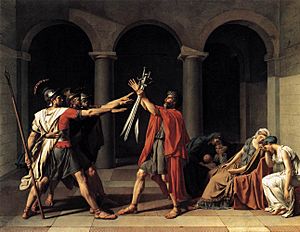Classicism facts for kids

Classicism is a style in the arts that looks back to the ancient Greek and Roman times. It sees their art and ideas as the best examples to follow. People who like Classicism try to create art that has the same qualities as ancient Greek and Roman works.
This style has been important in Europe and places influenced by Europe for a long time. Some periods, like the Age of Enlightenment, felt especially connected to these old ideas. During the Enlightenment, a movement called Neoclassicism became very popular in visual arts like painting and sculpture.
Contents
What is Classicism?

Classicism is a way of thinking that shows up in many forms of art. This includes literature, architecture, painting, music, dance, and philosophy. It gets its ideas from ancient Greece and Rome. It often focuses on ideas about society and how things should be balanced and orderly.
Classicism in Theatre
In the theatre, Classicism became popular in 17th-century France. French playwrights (people who write plays) looked at what they thought were the rules of ancient Greek theatre. They used these rules to create their own plays.
Classicism in Architecture
Classicism in architecture started during the Italian Renaissance. Important figures like Leon Battista Alberti and Filippo Brunelleschi helped develop it. This style focuses on symmetry (things being the same on both sides) and proportion (parts fitting together well). It also uses geometry in its designs. These ideas came from the buildings of ancient Rome, many of which still exist today.
Classicism in Painting and Sculpture
Italian Renaissance painting and sculptures brought back many classical forms and subjects. Artists used ideas and themes from ancient Greek and Roman art. Later, in the mid-18th and 19th centuries, Classicism in painting and sculpture is usually called Neoclassicism. This was a time when artists again strongly looked to ancient art for inspiration.
Related Pages
Images for kids
-
Molière in classical dress, by Nicolas Mignard, 1658.
-
Villa Rotonda, by Andrea Palladio, 1591.
See also
 In Spanish: Clasicismo para niños
In Spanish: Clasicismo para niños




